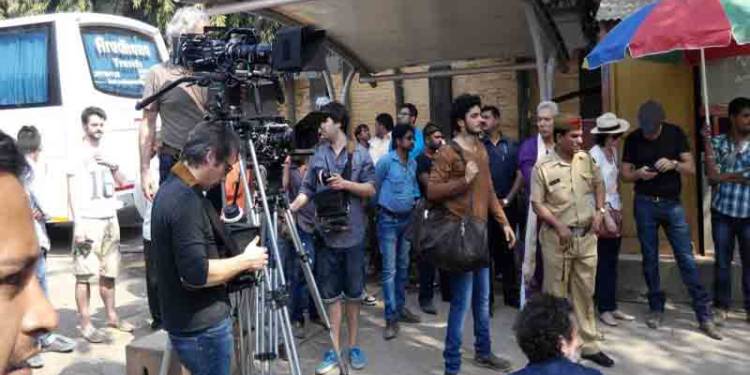On Saturday, PM Modi met Bollywood stars at his residence in New Delhi. The program was organized to celebrate 150 years of Gandhi and spread his ideals through cinema industry. A 1:40 minute video, with the theme of ‘Change within’ was also released by Filmmaker Rajkumar Hirani. In the short film, eight leading actors from Bollywood were talking about the ideals of Gandhi.
“The film fraternity comes together to pay tributes to Mahatma Gandhi! #ChangeWithin is an excellent effort, which will add momentum towards ensuring Gandhi Ji’s message reverberates far and wide. It will also inspire citizens to take up causes dear to Bapu,” tweeted PM Modi.
The film fraternity comes together to pay tributes to Mahatma Gandhi!#ChangeWithin is an excellent effort, which will add momentum towards ensuring Gandhi Ji’s message reverberates far and wide. It will also inspire citizens to take up causes dear to Bapu. pic.twitter.com/cS0RRekqTd
— Narendra Modi (@narendramodi) October 19, 2019
A University of Cinema mooted by PM Narendra Modi can democratise the film industry and strengthen India’s soft power through cinema. Shah Rukh Khan called the idea ‘extremely opportune’.
Thank u @narendramodi for hosting us & having such an open discussion on #ChangeWithin & the role artistes can play in spreading awareness of the msgs of The Mahatma. Also the idea of a University of Cinema is extremely opportune! pic.twitter.com/kWRbNk3xzo
— Shah Rukh Khan (@iamsrk) October 19, 2019
A cinema university is the need of the hour for the country. The country has many dedicated universities for Agriculture, Petroleum and Energy studies, and the union cabinet also approved Sports University in Delhi.
But the study of cinema is not organized yet. There are two autonomous institutes under Ministry of Information and Broadcasting (FTII, Pune and SRFTI, Kolkata) and one under Ministry of culture (National School of Drama), and while the cinema industry needs lakhs of skilled manpower every year, these institutes do not admit even 500 students every year.
Therefore, to bridge this demand deficit, a cinema university should be established.
Also, the old institutes have are deeply embedded with Nehruvian ideology. This could be seen in the kind of ideology that graduates from these institutes propagate. Majority of the film actors and producers and leftist and do not stand for Nationalist values. People like Aparna Sen Gupta, Shah Rukh Khan, Kamal Hassan, Prakash Raj form the intellectual core of the Indian film industry.
In the last few years, there has been a surge in the number of movies focused on middle class and non-metropolitan cities. Last year, few Nationalist movies like Uri and Kesari were produced. Otherwise, the old school of Bollywood played on extremes. On one side there were movies like Slumdog Millionaire which capitalized on poverty in India and on the other extreme there were Karan Johar’s movies which took you to altogether a different richie-rich world.
The democratization of Indian Cinema has gone parallel to the rise of filmmakers, stars from families with non-cinema background. Actors like Kangana Ranaut, Ayushman Khurana, and Vicky Kaushal are examples of democratization of Indian Cinema.
A cinema university will give a chance to talented youngsters from non-cinema background to make entry in the film industry. Majority of actors, directors from non-cinema background are graduates of three government-funded autonomous institutions. A cinema university will formalize entry in film industry and weaken blatant Nepotism that prevails.
Moreover, it will give the Directors and producers and pool of talent to choose from and the choices will not be limited to a few government-funded schools and star-kids.
Indian Cinema is the largest in the world in terms of number of films produced and tickets sold every year. A total of 1,813 films were produced in India in 2018 and, 3.5 billion tickets were sold. Indian cinema is far ahead of Hollywood in both measures, which produced only 660 films and sold 2.6 billion tickets worldwide. However, American film industry leads in terms of total revenue from tickets.
Hollywood destroyed the film industries in European countries as well as in East Asia. But, the Indian Film industry remains resilient against aggressive expansion of Hollywood and growing at higher pace.
In the Forbes list of highest-paid actors 2018, only actors from Hollywood and Bollywood got place, which reemphasizes that fact that only Indian film industry could be compared to American industry. Actors from other film industry of other countries like China, United Kingdom, Nigeria stand nowhere in comparison to Hollywood and Bollywood.
In the top 10, two actors were from Bollywood (Akshay Kumar, Salman Khan) while the rest were from Hollywood. This also indicates that Bollywood has a long way to go to make a deeper global presence. Some Bollywood movies have performed exceptionally well on a global scale, especially in large emerging markets like China but it has a long road to travel.
The number of cinema screens in India is around 9,000 and, is growing at double-digit. As per a report by Federation of Indian Chambers of Commerce and Industry (FICCI) in consultation with Ernst & Young (EY), titled, ‘A billion screens of opportunity’, Indian Media & Entertainment (M&E) industry grew by 13.4 per cent to 1.67 lakh crore 2018.
Media & Entertainment industry is small in terms of contribution of Indian economy but has disproportionate influence on public opinion. Cinema is extremely powerful to project soft power of the country. Today, Bollywood has started to enjoy immense popularity in the Western world, South Asia, and a few African countries. South Indian movie stars are very popular in Southeast Asian countries like Malaysia, Indonesia and Thailand as well as in Middle Eastern countries.
A Cinema university, which will democratize the entry in Film industry and, destroy the old leftist ecosystem is the need of hour. Modi government should work swiftly towards the goal.































